In the last two months, Eastern India has suffered a familiar disaster: disastrous floods that have buried farmlands, displaced thousands, and brought daily life to a halt. From overflowing rivers in Bihar and West Bengal to embankment breaches in Odisha, this year’s monsoon has revealed not only a climatic pattern but also a policy failure that has been years in the making.
The magnitude of destruction is astonishing. Numerous people have been affected throughout the region, hundreds of villages are still waterlogged weeks after the worst rains, and important segments of rural roads and railways have been wiped away. Crop losses are increasing, with paddy, maize, and vegetable growers reporting total damage in some low-lying areas. However, as the water levels gradually recede, so does public attention—until the next flood occurs.
What distinguishes these floods from other monsoon disasters is that the science is obvious and the hazards are well understood, but government intervention has been slow and piecemeal. In a region already at the forefront of climate vulnerability, the consequence of inaction is no longer hypothetical. It’s human, economic, and political.
A predicted disaster
Monsoon patterns are becoming more intense and irregular, as has been reported for decades. Reports from the Indian Meteorological Department and the Intergovernmental Panel on Climate Change have consistently revealed that the Gangetic basin is warming, resulting in more irregular rainfall and heavier downpours in shorter windows. In Bihar alone, the flood-prone territory is projected to be over 68 lakh hectares, or nearly 73% of the state’s geographical area.
This is not a sudden occurrence. Every year, the same rivers overflow. Embankments break under pressure. Disaster assistance camps are hurriedly established. However, what should have been a long-term adaptation strategy is now handled as a yearly emergency occurrence. Most state flood management strategies prioritize relief delivery above prevention. Flood control embankments in numerous North Bihar districts originate from the 1960s and have received no modern strengthening. In West Bengal, breaches in aging irrigation canals have exacerbated floods in rural areas. Climate change has only exacerbated an already weak infrastructure.
The economic consequences of neglect
The economic ramifications of such recurring tragedies are significant. The 2024 floods in Eastern India resulted in about ₹10,000 crore in crop losses, as estimated by state governments. Farmers relying on seasonal paddy farming are experiencing crop failures for the third year in a row. For marginal farmers and landless laborers, this is more than simply a temporary setback; it represents a collapse in livelihood stability. Flooding also forces rural households into debt traps. Informal borrowing for agricultural losses, home repairs, and medical emergencies creates long-term economic instability.
Migration to cities rises in the months following floods, when seasonal labor becomes the sole source of income for thousands of young men. The infrastructure loss is equally serious. Road networks are routinely washed out, which disrupts supply chains and public transportation. Electricity distribution in some West Bengal blocks was knocked off for about two weeks this year. Health clinics and schools in flood-prone areas are routinely used as relief shelters, delaying crucial services for months.
This recurring devastation has costly ramifications. Every year, the federal government and states spend billions of dollars on flood relief—money that might have gone toward climate adaptation measures like strong infrastructure, early warning systems, and green drainage projects.
Climate inaction is politics
The failure to confront recurring floods in Eastern India is more than just a technical problem; it is deeply political. Disaster management remains locked in short electoral cycles, with rapid relief receiving more attention than preventive preparation. Compensation and relief package announcements generate headlines, but upstream dam management, floodplain zoning, and drainage reform are buried in files.
The absence of collaboration among nations exacerbates the problem. The Kosi River, for example, flows from Nepal into Bihar, implying that efficient flood management necessitates interstate and international cooperation. However, early warning systems and data sharing remain ineffective. In Odisha, state officials have frequently emphasized the significance of improved cooperation on dam releases upstream, but reaction systems remain reactive.
This governance gap is widening as climate change increases the frequency and intensity of extreme weather events. The region is experiencing “compounded disasters,” in which heavy rains combine with inadequate infrastructure, poor drainage, and administrative inertia to intensify the devastation.
The Forgotten Climate Frontline
Eastern India is rarely mentioned in the national climate debate, which is driven by discussions about solar parks, green hydrogen, and urban adaptability. However, states such as Bihar, Odisha, and West Bengal are among the most climate-vulnerable in the country. According to a recent report by the Council on Energy, Environment, and Water, more than 80% of Bihar’s districts and over 70% of West Bengal’s districts are very vulnerable to extreme climate events. This vulnerability is also socioeconomic. Floods regularly affect the poorest communities, including Dalits, Adivasis, and landless people living in informal settlements along riverbanks. Floods are more than an environmental issue for them; they are about survival and justice.
However, climate justice is still missing from state-level adaptation programs. The lack of local participation in planning, insufficient social protection measures, and inconsistent implementation of early warning systems put already disadvantaged areas at risk.
What should change?
The 2025 floods should be viewed as a failure of climate governance rather than a natural occurrence. There are specific methods that can help the region transition from reactive relief to proactive resilience. First, floodplain zoning and land use regulations must be enforced. Rampant building on floodplains, especially public infrastructure, has hampered drainage and increased damage. Second, climate-resilient infrastructure like reinforced embankments, natural drainage restoration, and adaptable agriculture systems necessitate long-term investment rather than one-time funding. Third, community-based early warning systems and local disaster management need to be developed.
Finally, climate adaptation must be integrated into development planning, rather than treated as a separate policy silo. Roads, housing, health, and energy infrastructure in these states must be built to withstand future climatic shocks, not just previous averages.
A political option
Climate change is no longer a remote threat to Eastern India. It is here, right now, and it is changing the lives of millions. This year’s floods are part of an increasingly expected cycle. Whether this continues to be a tragedy or becomes a watershed moment is entirely up to political will.
India’s energy transition and climate policy cannot be really “green” or “just” if they exclude the regions that bear the greatest burden of climate inaction. Eastern India requires more than simply relief; it deserves resilience.




